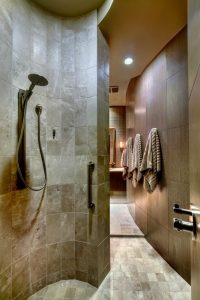What Should You Consider if You Want to Install a Wet Room?
A newer trend in bathroom design is the “wet” room which adds the sense of a luxurious spa experience. As a professional interior designer in Bergen County, NJ, clients often ask me about the pros and cons of installing a wet room in their bathroom.
What is a “wet room”?
This is a bathroom, usually the master bathroom, where the shower is open or set behind a single wall. The flooring is continuous with the rest of the room. Water drains away from the rest of the room through a series of floor drains. Today, a “wet room can also include a free standing tub behind the wall which is usually glass, to expand the look of the space.
Containing the water so it doesn’t overflow into the dry area of the bathroom is the most important consideration when deciding on this option.

What are some of the benefits of creating a “wet” room?
#1. The most important benefit is opening up the space, both visually and functionally.
#2. Another important feature is accessibility for a variety of bathers. Sometimes referred to as a threshold free area, a wheel chair can be easily get in and out. No issues with stepping over a barrier. This is universal design at its best.
What are some of the issues of creating a “wet” room?
#1. How to keep the items that you need to be dry can be a challenge. [Like the toilet and toilet paper! And your towel!]
#2. Water contained up to the threshold of the shower area is another challenge. That is known as water creep. Planning out the floor level and placement of drains is critical.
#3. Water proofing in a “wet” room is different than in traditional bathrooms. Non-slip and non-porous flooring materials must be used throughout the bathroom. Floor to ceiling installation is needed which is an added expense, but adds to the practicality and spa-like feel.
#4. Should you put in a door or not? If there is no door, heat created in the shower will go out to the rest of the space and may be uncomfortable for the bather. A door will help, but what kind of door?
Here’s a little story for you…
I few years ago I had an experience with a “wet” room in one of the best hotels in London. The large bathroom had two sides. The dry side had a tub, no shower equipment, and a vanity with a sink. There was a wall between the two sides, that had an opening, no door. This led to the “wet” room side. The wall between dry and wet spaces held the plumbing for the toilet. Across from the toilet was the shower. I guess they didn’t care if the toilet was wet from the shower. The entire room was marble clad, which was beautiful but got really slippery when wet.
Two drains on the floor went across the entire back wall. There were two well-spaced shower heads on the back wall. That meant that two people could shower at the same time! Great idea!
I went to take a shower and put my towel on the closed top of the toilet since there were no hooks. I started the water on my side of the shower. To my horror the water on the floor started to pile up and climb the floor! It was heading out to the dry room.
I quickly gathered all the towels in the bathroom and folded them into long rolls placing them across the opening to the dry side of the bathroom! I quickly finished my shower and toweled off with the only dry towel left.
What a terrible way to install a “wet” room! Such bad planning! When I went downstairs I asked the manager if they had this issue in all the bathrooms done this way. She said YES! Fixing this problem was going to be a very costly proposition for them.
Incorporating a “wet” room into your bathroom remodeling offers terrific design options, but careful space planning is a must to create a successful project.

